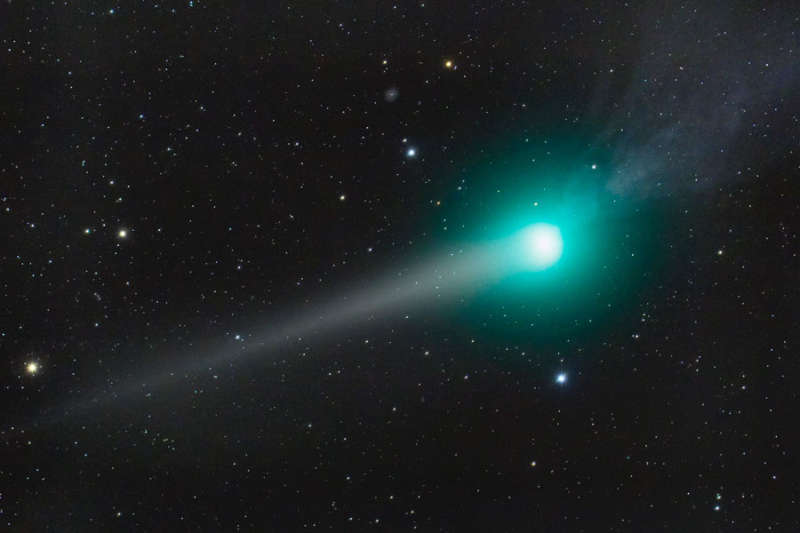
|
Credit & Copyright: Richard Richins
(NMSU)
Explanation:
Go outside tonight and see Comet Lulin.
From a dark location, you should need only a
good
star
map and
admirable
perseverance --
although wide-field binoculars might help.
Yesterday,
Comet Lulin passed its closest to Earth, so that the comet will remain near its brightest over the next few days.
The comet is currently almost 180 degrees around from the Sun and
so visible nearly all night long, but will appear to
move on the sky
about 10 full moons a night.
Pictured above,
Comet Lulin was captured in
spectacular form two nights ago from New Mexico, USA.
The central coma of the comet is appearing quite green, a color likely indicating
glowing
cyanogen and molecular
carbon gasses.
Bright stars and a distant
spiral galaxy
are clearly visible in the image background.
The yellow dust tail, reflecting sunlight, is
visible sprawling to the coma's left trailing behind
the comet, while the textured bluish-glowing ion tail is visible to the coma's
right, pointing away from the Sun.
Over the past few weeks, from the current vantage point of Earth, these
two tails appeared to point in opposite directions.
Comet Lulin is expected to slowly fade over the next few weeks.
|
January February March April May June July August September October November December |
| ||||||||||||||||||||||||||||||||||||||||||||||||
NASA Web Site Statements, Warnings, and Disclaimers
NASA Official: Jay Norris. Specific rights apply.
A service of: LHEA at NASA / GSFC
& Michigan Tech. U.
Based on Astronomy Picture
Of the Day
Publications with keywords: comet - comet tail
Publications with words: comet - comet tail
See also:
- APOD: 2025 September 30 Á Comet Lemmon Brightens
- APOD: 2025 September 29 Á Two Camera Comets in One Sky
- APOD: 2025 September 26 Á A SWAN an ATLAS and Mars
- APOD: 2025 September 18 Á Comet C/2025 R2 SWAN
- APOD: 2025 September 16 Á New Comet SWAN25B over Mexico
- APOD: 2025 July 7 Á Interstellar Comet 3I ATLAS
- Comet C/2025 F2 SWAN
